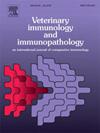Phagocytosis and reactive oxygen species (ROS) production by CH138+ granulocytes isolated from blood, colostrum, and milk of Holstein cows during transition period
IF 1.4
3区 农林科学
Q4 IMMUNOLOGY
引用次数: 0
Abstract
This study investigated the functional activity of CH138 + granulocytes in the blood, colostrum, and transitional milk of Holstein cows throughout the transition period. Thirteen cows were assessed weekly, beginning three weeks before calving (W-3, W-2, and W-1), on the day of calving, and continuing to three weeks postpartum (W1, W2, and W3). Physical examination of the udder tissue, bacterial cultures, and blood immune function tests were performed. Microscopic Somatic Cell Count (MSCC), phagocytosis, and intracellular ROS production by CH138 + granulocytes in colostrum and transitional milk were measured weekly, from calving to W3. Disease incidence was recorded, with four cows developing metritis at W2. Mammary gland edema, affecting parenchymal tissue consistency, was the main physical finding. Non-Aureus Staphylococcus spp. dominated the bacterial isolates from the mammary secretions (67.5 %). MSCC was highest in colostrum and decreased postpartum. Bacterial culture rates peaked at calving; however, colostrogenesis limited the detection of clinical mastitis through specific examinations. Blood neutrophil function decreased at W-2 and W-1, likely increasing the risk of mammary infection and weakening the neutrophil response at calving. This immune suppression, which affects both the mammary gland and systemic immunity, was exacerbated by postpartum metritis. The findings showed heightened vulnerability to bacterial infection postpartum, which was linked to reduced cell viability and CH138 + granulocyte function. Neutrophil function in mammary secretions gradually improves post-calving, supporting immune recovery and declining infection rates. These findings provided valuable insights into the immune adaptations of CH138 + granulocytes in colostrum and transitional milk, enhancing understanding of mammary and systemic immune responses during the transition period.
过渡期荷斯坦奶牛血液、初乳和乳中CH138+粒细胞的吞噬作用和活性氧(ROS)产生。
本研究旨在研究荷斯坦奶牛过渡期内血液、初乳和过渡乳中CH138 + 粒细胞的功能活性。每周对13头奶牛进行评估,从产犊前3周(W-3、W-2和W-1)开始,从产犊当天开始,一直持续到产后3周(W1、W2和W3)。进行乳腺组织、细菌培养和血液免疫功能检查。从产犊至W3,每周检测初乳和过渡乳中CH138 + 粒细胞的显微体细胞计数(MSCC)、吞噬和细胞内ROS生成。记录了疾病发病率,有4头奶牛在W2时出现子宫炎。主要表现为乳腺水肿,影响实质组织的一致性。从乳腺分泌物中分离出的细菌以非金黄色葡萄球菌为主(67.5% %)。MSCC在初乳最高,产后降低。细菌培养率在产犊时达到峰值;然而,乳腺炎的发生限制了临床乳腺炎的特异性检查。在W-2和W-1时,血液中性粒细胞功能下降,可能增加了乳房感染的风险,并削弱了产犊时的中性粒细胞反应。这种影响乳腺和全身免疫的免疫抑制因产后子宫炎而加剧。研究结果显示,产后易受细菌感染,这与细胞活力和CH138 + 粒细胞功能降低有关。乳腺分泌物中性粒细胞功能在产犊后逐渐改善,支持免疫恢复和降低感染率。这些发现为初乳和过渡乳中CH138 + 粒细胞的免疫适应性提供了有价值的见解,增强了对过渡期间乳腺和全身免疫反应的理解。
本文章由计算机程序翻译,如有差异,请以英文原文为准。
求助全文
约1分钟内获得全文
求助全文
来源期刊
CiteScore
3.40
自引率
5.60%
发文量
79
审稿时长
70 days
期刊介绍:
The journal reports basic, comparative and clinical immunology as they pertain to the animal species designated here: livestock, poultry, and fish species that are major food animals and companion animals such as cats, dogs, horses and camels, and wildlife species that act as reservoirs for food, companion or human infectious diseases, or as models for human disease.
Rodent models of infectious diseases that are of importance in the animal species indicated above,when the disease requires a level of containment that is not readily available for larger animal experimentation (ABSL3), will be considered. Papers on rabbits, lizards, guinea pigs, badgers, armadillos, elephants, antelope, and buffalo will be reviewed if the research advances our fundamental understanding of immunology, or if they act as a reservoir of infectious disease for the primary animal species designated above, or for humans. Manuscripts employing other species will be reviewed if justified as fitting into the categories above.
The following topics are appropriate: biology of cells and mechanisms of the immune system, immunochemistry, immunodeficiencies, immunodiagnosis, immunogenetics, immunopathology, immunology of infectious disease and tumors, immunoprophylaxis including vaccine development and delivery, immunological aspects of pregnancy including passive immunity, autoimmuity, neuroimmunology, and transplanatation immunology. Manuscripts that describe new genes and development of tools such as monoclonal antibodies are also of interest when part of a larger biological study. Studies employing extracts or constituents (plant extracts, feed additives or microbiome) must be sufficiently defined to be reproduced in other laboratories and also provide evidence for possible mechanisms and not simply show an effect on the immune system.

 求助内容:
求助内容: 应助结果提醒方式:
应助结果提醒方式:


